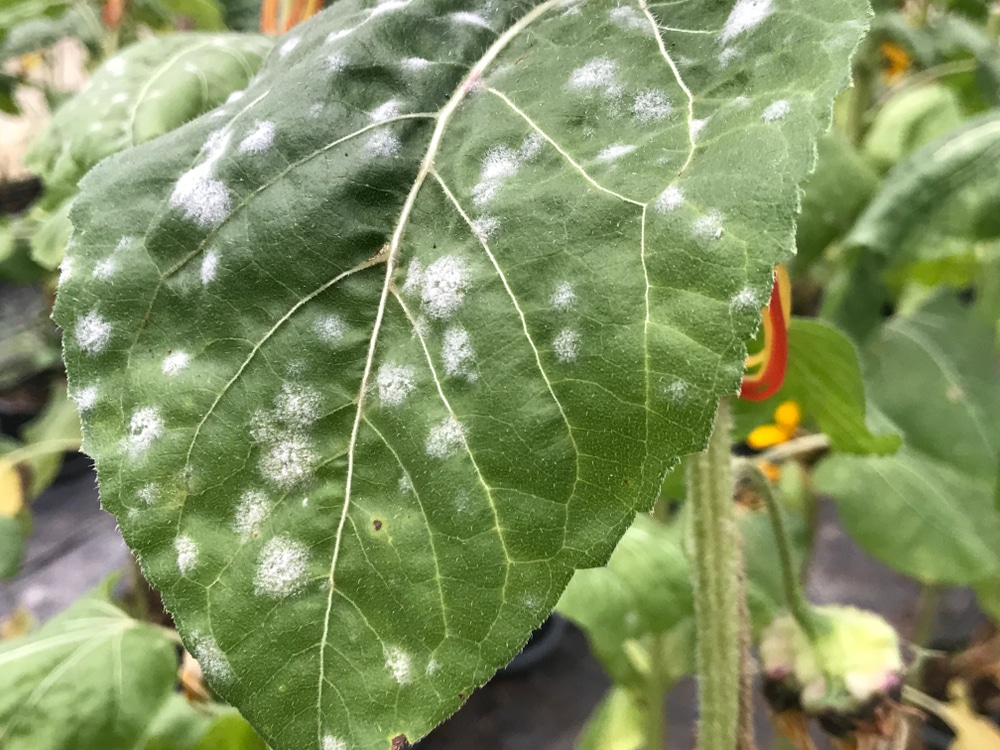Sunflowers are a popular choice for gardens and farming, whether they’re being grown for their cheery yellow flowers or their edible seeds. These plants are native to the Americas but have become popular globally. If your sunflowers look unhealthy, one way to identify the problem is the leaves. A common symptom of a sickly plant is black spots on sunflower leaves.
Below we’ll take a closer look at the several sources that could be causing this problem on sunflowers and how to address them.
Phoma Black Stem
Phoma Black Stem usually starts in the leaves and spreads into the stem despite the name. Therefore, if you notice black lesions on leaves, especially close to the stem, you may be dealing with the beginning stages of the disease.
At later stages, legions spread, killing off leaves and darkening the stem starting at the bottom of the plant. Luckily, this fungal disease causes primarily superficial damage.
Treatment: Fungicides aren’t effective on this plant, but keeping sunflowers pest free lowers their susceptibility. Look for resistant sunflower cultivars and practice frequent crop rotation to avoid encountering this disease.
Powdery Mildew
Though Powdery Mildew is usually spotted from the white fungal spots on the top of the leaf, black specks also appear on the bottom of infected leaves. The mildew makes leaves look droopy and covered in powder but rarely slows growth or kills sunflowers.
Treatment: Fungicides can be used in extreme cases, but this is rarely necessary, especially in sunflowers. These are only effective when used preventatively in healthy plants.
In most cases, Powdery Mildew clears up on its own once conditions, like humidity, improve, improve. Consider airflow when planting your sunflowers and prune back excessive foliage.
Rust Disease
Black spots on sunflower leaves may be signs of rust, though if you catch Sunflower Rust early in the season, the specks may appear yellow to orange in color. Later these spots turn brown and black.
Another fungal disease that usually presents late in the season, Sunflower Rust kills off infected leaves but doesn’t pose a considerable threat unless detected early in the growing season. Prevent new infections from old crops by burying them and controlling volunteers.
Treatment: Fungicides treat Sunflower Rust but may not be required if rust is not severe. Pinching off infected leaves may also help during the early stages of the spread. The best way to prevent rust is to grow resistant cultivars.
Septoria Leaf Blight
Small discolored spots are the first sign of Septoria Leaf Blight. Over time these discolorations form legions filled with tiny black specks. This fungal disease usually works its way from the bottom of the sunflower up.
Septoria Leaf Blight is often confused with Bacterial Leaf Spot or Alternaria Leaf Blight. The noticeable difference between the two is that bacterial disease causes holes in the leaf, usually surrounded by yellow.
Treatment: Unlike some fungal diseases, Septoria Leaf Blight isn’t spread through the soil but survives on plant material. If you’ve dealt with this blight once, bury or burn any affected material to prevent it from cropping up next season.
Infected leaves can also be removed if growing lower on the plant to stop Septoria Leaf Blight. Several fungicidal sprays also effectively remove the blight. Planting resistant cultivars is an excellent preventative measure.
Final Thoughts
There’s no reason to panic, no matter the source causing black spots on sunflower leaves. Many of these problems have simple solutions and won’t severely harm your plants except in extreme cases.
Notably, humidity and damp vegetation cause many common sunflower problems. So one of the best things for sunflowers is to provide a warm, dry growing space with good airflow.

